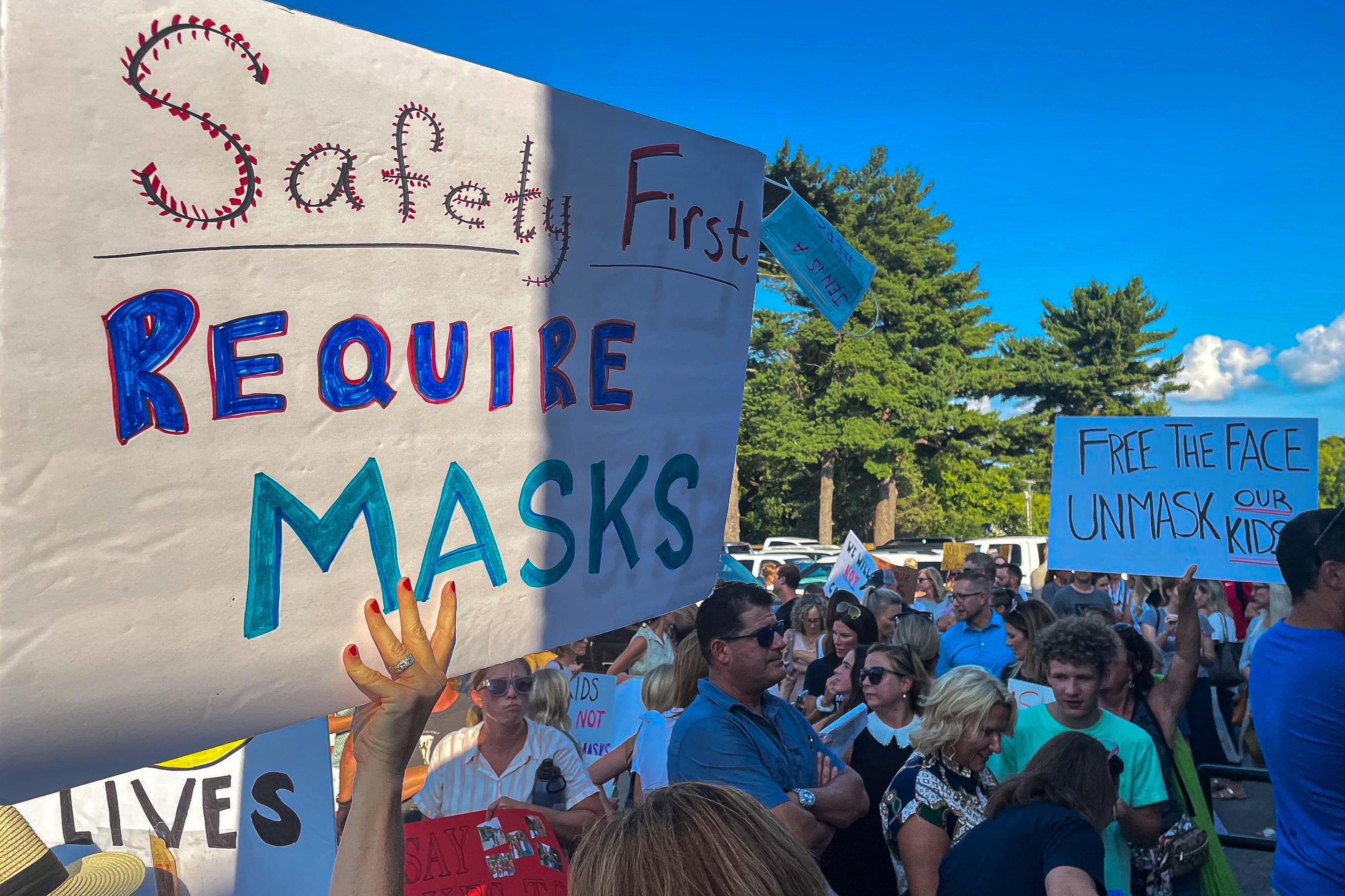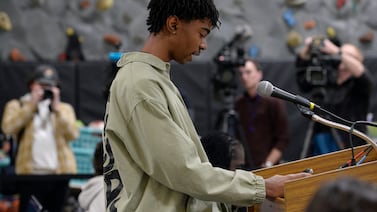In the battle over masking in schools, everyone claims to have science on their side.
When Florida Gov. Ron DeSantis issued an executive order seeking to ban mask mandates in schools, he claimed that “forcing students to wear masks lacks a well-grounded scientific justification.” A recent New York Magazine piece came to a similar conclusion from a number of recent studies, describing the value of masking in schools “at best, uncertain.”
But more schools are in fact moving to require masks for all — including the biggest districts in Florida, defying DeSantis. Officials point to guidance from the Centers for Disease Control and Prevention and the American Academy of Pediatrics, rising COVID case numbers driven by the more transmissible delta variant, and comments from some prominent epidemiologists.
“Universal masking in schools can save lives,” two Duke University pediatrics professors wrote in the New York Times this month.
Is it possible for there to be so little certainty about something so fundamental, 17 months into the pandemic? What does the evidence really say about masks in schools, particularly for students?
Chalkbeat dove back into the research. In short, existing studies focusing on schools — including those cited on both sides of the debate — are strikingly limited. Little if any research has definitively shown what effect masks have on COVID spread in schools.
At the same time, there is a broader body of evidence collected in other settings that suggests that masks help prevent the spread of respiratory diseases like COVID-19. That appears to be what’s driving health authorities to recommend masking in the classroom, alongside a general desire to minimize the risk to children and communities when cases are rising.
Here’s a more detailed guide to what we know.
Yes, the research on schools and masks is quite limited.
In the Times piece, the Duke professors cite their own work showing that COVID spread was limited in a number of North Carolina districts that adopted universal masking. That — along with outbreaks among children in settings where masking was not widespread — is compelling evidence that masks work, they say. The CDC cites similar evidence.
But this sort of research cannot prove that masking made the difference. That’s because it doesn’t compare schools with masking requirements to those without them, a point writer David Zweig emphasizes in New York Magazine.
Zweig focuses instead on a CDC study that did have such a comparison group. That research, which he describes as “ambitious and groundbreaking,” examined 169 schools in Georgia and found that schools with student mask requirements had a 21% lower COVID rate among students than schools without mandates. But this difference was not statistically significant, meaning researchers couldn’t be confident it wasn’t just due to luck.
“It’s entirely possible that open windows or fresh-air ventilation accounts for nearly all the mitigation benefit in a classroom and other ‘layered’ interventions may contribute only a marginal benefit or none at all,” concludes Zweig.
But this study ultimately isn’t all that helpful, either. What if the schools without mask requirements had additional precautions in place, or there were other differences between those schools or the communities they serve?
The researchers made little attempt to account for other factors, and acknowledged in the paper that their results “cannot be used to infer causal relationships” — a crucial limitation.
In fact, it’s not clear that any of the most cited studies examining masks in schools are able to pin down cause and effect. “All of the studies that I have seen,” said Tulane University epidemiologist Susan Hassig, “are not sufficiently rigorous to assess the actual effectiveness of masks” in schools.
The CDC did not respond to a request for comment about the evidence the agency has relied on to develop masking guidance for schools.
There is a stronger scientific case for masking in general, though this research also has limitations.
Some experts say we should look beyond research on masking in schools and keep the basic logic of masking in mind.
COVID-19 “is transmitted predominately by inhalation of respiratory droplets generated when people cough, sneeze, sing, talk, or breathe,” explains the CDC. The logic of masks, then, is straightforward. They can block particles, protecting the wearer and limiting transmission from an individual who has the virus. Masking is particularly important for a disease like COVID-19 where an infected individual can transmit the disease before developing symptoms (and thus realizing they should stay home).
Laboratory simulations confirm that masks stop many — though not all — of these droplets that could contain the virus.
“The bottom line is: you go through a smoky building, you’re gonna want to have a mask on,” said Hassig. Similarly, “we don’t want to be inhaling air with virus in it.”
A separate question is whether masks work in the real world. The CDC says the answer is yes, pointing to at least 10 studies of COVID transmission in communities.
For instance, researchers in Thailand interviewed people who had close contact with an infected individual, and found those wearing masks at the time were much less likely to later test positive for the disease. Another paper found that after Washington D.C. mandated face masks in public, COVID rates declined.
Jeremy Howard, author of a review of masking research and a research scientist at the University of San Francisco, says the benefits of masks very likely apply in school. “For masks in schools, the weight of evidence, when you combine it all together, is very strong,” he said.
Sarah Bode, a pediatrician in Columbus, Ohio who helped draft the AAP school recommendations, said it’s the multiple lines of research on masking — including the experience of adults — that led to the organization’s guidelines.
“Some of this is taking all those different pieces and using all the evidence to make your best guidance,” she said. “We want to protect our children.” (Compared to adults, children are at much lower risk of severe COVID outcomes, including hospitalization and death, although cases and hospitalization rates have risen along with the delta surge.)
Still, some experts aren’t convinced of the value of masking in schools. They point out that the studies that the CDC cites about masking in general may not be able to pin down cause and effect either. They also wonder if conclusions about adults really apply to children.
“Here is the real answer to the question of whether it’s worth it to mask kids: No one has any clue. During the last year and half, the scientific community has failed to answer these questions,” wrote Vinay Prasad, a professor at the University of California San Francisco school of medicine.
Even advocates of masking in schools acknowledge that the evidence isn’t as robust as they’d prefer, with no randomized experiments.
“That would be the ideal study,” said Mike Smith, a pediatrics professor and epidemiologist at Duke. “We have to make decisions weighing the risks and benefits without the gold standard randomized-controlled trial data.”
Masking decisions ultimately come down to weighing tradeoffs.
There’s no question that masks can affect teaching and learning. Students may have a harder time hearing a masked teacher and vice versa, especially in classes when some students are learning remotely. Classes like band and physical education become more complicated. Some students with specific disabilities find masks particularly challenging.
“We had kids with sensory issues, and the mask irritates that. I would try to explain why we’re doing it: to protect you, to protect your family, to protect our families,” Christina Sarraino, an intervention specialist who teaches high schoolers with social and emotional challenges, previously told Chalkbeat. “Explaining all of that and trying to get to academics and their social and emotional needs, with everything going on, was difficult.”
Because of these issues, some countries have opted against recommending masking for all students in schools. “Overall, we think it is important not to interfere with learning as much as possible, so it’s about balancing up the benefits against the potential harms,” said New Zealand public health director Caroline McElnay, who recommended against required face coverings in schools. (The policy is currently sparking debate there as the delta variant raises new concerns.)
But forgoing masks also comes with educational risks. Polls show most parents support school mask mandates, and some — particularly families of color and those with immunocompromised children — may resist sending their child back for in-person instruction if masks aren’t required.
Bode, the pediatrician, says that there is little reason to think that masking in schools will do long-run harm in children, and that schools should accommodate students who have specific needs that make masking inappropriate.
Ultimately, she argues, masks will help keep schools open during the delta surge, and the benefits of in-person school outweigh any downsides of masking.
“The social emotional effect of being isolated and at home in virtual learning because there’s been COVID outbreaks in your school is far greater,” Bode said.





